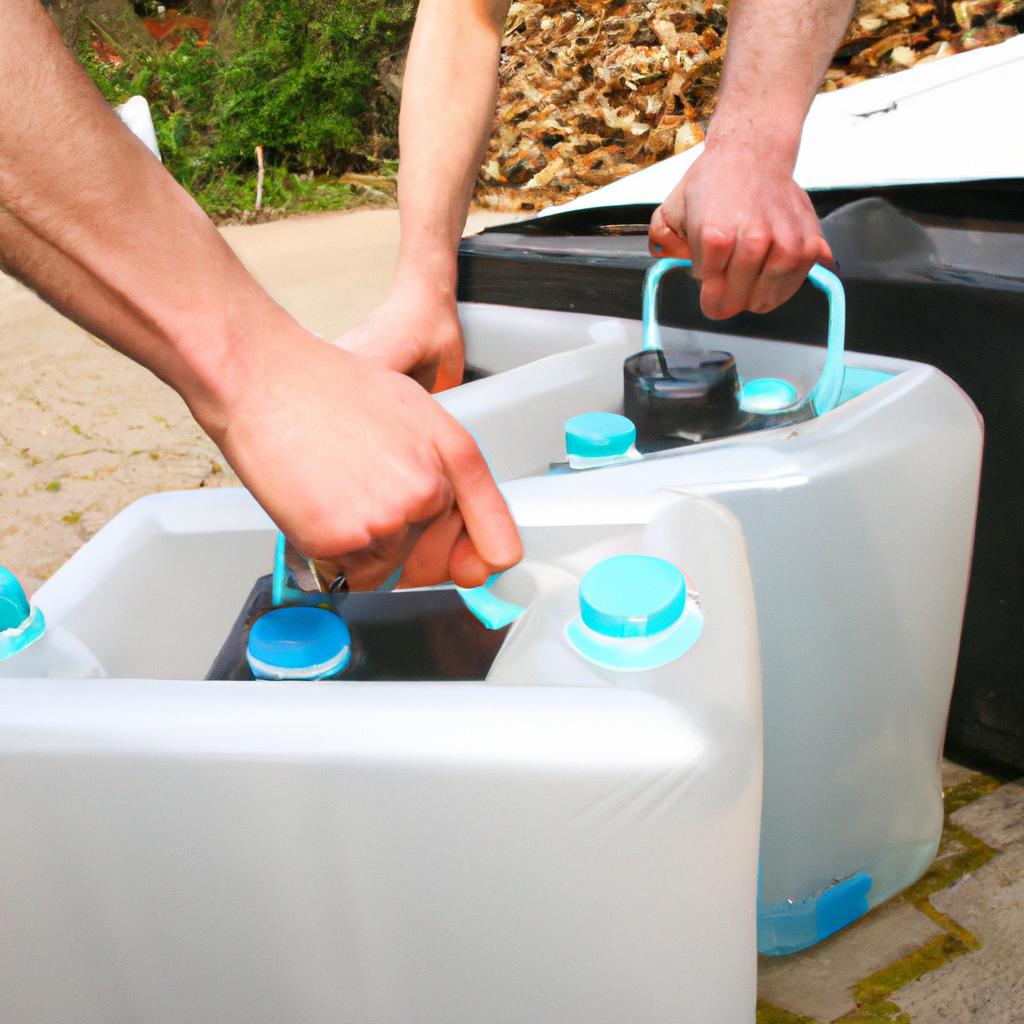In times of emergencies and natural disasters, having a well-stocked emergency kit can make all the difference. Among the essential items that should be included in such kits are batteries. Batteries serve as reliable power sources for various devices, ensuring communication, illumination, and other critical functions when electricity is disrupted. For instance, consider a hypothetical scenario where a severe storm knocks out power lines in a remote area. In this situation, individuals with batteries readily available would have an advantage over those who do not possess them.
Understanding the key aspects of batteries is crucial for effectively utilizing them in emergency situations. This article aims to provide essential information regarding battery types, their capacities, and proper storage guidelines for inclusion in emergency kits. By examining these factors, readers will gain insights into making informed decisions about which batteries to choose based on their specific needs and circumstances. Additionally, we will explore common misconceptions surrounding battery usage during emergencies and debunk myths that may hinder efficient utilization of this indispensable resource. Ultimately, by comprehending the essentials of batteries within the context of emergency preparedness, individuals can better equip themselves for unforeseen events and ensure their safety and wellbeing during trying times.
Types of batteries to include in your emergency kit
Imagine this scenario: a severe storm has knocked out the power in your neighborhood, leaving you and your family without electricity. In situations like these, having an emergency kit with essential supplies becomes crucial. Among the items that should be included in such a kit are batteries. Batteries provide portable power for various devices, allowing you to stay connected and informed even during emergencies.
When choosing which types of batteries to include in your emergency kit, it is important to consider their longevity and compatibility with common household electronics. The following three paragraphs will discuss the different types of batteries that are recommended for inclusion in your emergency kit.
Firstly, alkaline batteries are widely available and suitable for most everyday devices such as flashlights, radios, and clocks. These disposable batteries have a longer shelf life compared to other options and can provide reliable power when needed. However, they may not perform optimally under extreme temperature conditions.
Secondly, lithium-ion batteries offer several advantages over alkaline ones. They have a higher energy density, meaning they store more charge per unit volume or weight. This makes them ideal for high-drain devices like digital cameras or smartphones that require frequent charging. Additionally, lithium-ion batteries have a longer lifespan than alkaline ones but come at a higher cost.
Thirdly, rechargeable nickel-metal hydride (NiMH) batteries combine affordability with environmental friendliness. Unlike single-use alkaline or lithium-ion batteries, NiMH cells can be recharged multiple times before needing replacement. They are particularly suitable for low-drain devices such as remote controls or computer mice where long-term usage is desired.
In summary, when assembling an emergency kit, it is advisable to include a variety of battery types to cater to different device requirements and potential scenarios. Consider including alkaline batteries for general-purpose use due to their widespread availability and reliability. For high-drain electronic devices requiring frequent charging cycles, lithium-ion batteries offer superior performance. Lastly, rechargeable NiMH batteries are an economical and eco-friendly choice for low-drain devices with extended usage.
Moving forward to the next section about “How to properly store batteries for long-term use,” it is essential to understand the correct methods of preserving battery life and ensuring their optimal performance in times of need.
How to properly store batteries for long-term use
Types of Batteries to Include in Your Emergency Kit
Imagine this scenario: a severe storm hits your area, causing a power outage that lasts for several days. Without electricity, you are left without essential appliances and communication devices. In times like these, having an emergency kit stocked with the right batteries can make all the difference.
To ensure you have the necessary power supply during emergencies, it is crucial to include specific types of batteries in your emergency kit. Here are three categories to consider:
-
Alkaline Batteries: Alkaline batteries are widely used due to their long shelf life and reliability. They are suitable for low-drain devices such as flashlights, radios, and clocks. Consider including various sizes (AA, AAA, C, D) in your emergency kit to accommodate different gadgets.
-
Lithium Batteries: For high-drain devices like digital cameras or two-way radios, lithium batteries are ideal due to their superior performance in extreme temperatures and longer-lasting capabilities compared to alkaline counterparts.
-
Rechargeable Batteries: Including rechargeable batteries in your emergency kit not only reduces waste but also provides a sustainable option for extended use when access to electricity is limited. Remember to pack a compatible charger as well.
Now that you understand which types of batteries should be part of your emergency supplies let’s discuss how to properly store them for long-term use. This ensures they remain functional when needed most.
- Regularly check battery expiration dates
- Store batteries in a cool and dry place away from direct sunlight or extreme temperatures
- Avoid storing loose batteries together as they may discharge over time if they come into contact
- Keep batteries separate from metal objects or other conductive materials that could cause short circuits
| Battery Type | Shelf Life | Ideal Storage Temperature |
|---|---|---|
| Alkaline | 5-10 years | 60-80°F (15-27°C) |
| Lithium | 10+ years | -40 to 140°F (-40 to 60°C) |
| Rechargeable | Varies | Room temperature |
By following these storage guidelines, you can ensure that your emergency kit batteries are ready for use when emergencies strike. However, it is important to regularly check battery expiration dates to maintain their reliability and effectiveness.
The importance of regularly checking battery expiration dates will be discussed in the next section, as we delve into how expired batteries can impact your emergency preparedness plans.
The importance of regularly checking battery expiration dates
Case Study:
Imagine a scenario where a family is caught in the middle of a power outage during a severe storm. They reach for their emergency kit, which includes flashlights and radios powered by batteries. However, when they try to turn on these essential devices, they realize that the batteries have expired. This unfortunate situation emphasizes the criticality of regularly checking battery expiration dates.
Regularly monitoring battery expiration dates ensures that your emergency kit remains fully functional when you need it most. By adhering to this practice, you can avoid being caught off guard with unusable batteries during emergencies. Here are some key reasons why regularly checking battery expiration dates should be an integral part of your preparedness routine:
- Reliability: Batteries gradually lose their charge over time, even if unused. Regularly examining expiration dates allows you to replace old batteries promptly, ensuring reliable performance when needed.
- Safety: Expired batteries may leak or corrode within electronic devices, causing damage and potential harm to both individuals and property.
- Cost-effectiveness: By staying proactive and keeping track of expiry dates, you can prevent wasteful spending on unnecessary replacements due to expired batteries.
- Peace of mind: Maintaining up-to-date batteries provides reassurance that your emergency equipment will function optimally during unforeseen events.
To better understand the significance of regular checks on battery expiration dates, consider the following table highlighting common types of household batteries and their average shelf life:
| Battery Type | Average Shelf Life |
|---|---|
| Alkaline | 5-10 years |
| Lithium-ion | 10+ years |
| Nickel Metal Hydride (NiMH) | 2-7 years |
Through consistent monitoring and replacement based on expiration dates, you ensure that your emergency kit contains fresh power sources capable of meeting your needs effectively.
As you continue to prioritize the preparedness of your emergency kit, it is evident that regularly checking battery expiration dates remains an essential step. By doing so, you can mitigate potential risks and maintain the functionality of critical devices during emergencies.
Tips for maximizing the lifespan of your emergency kit batteries
Transitioning from the previous section on checking battery expiration dates, it is equally important to understand how to maximize the lifespan of batteries in your emergency kit. Let’s explore some tips that can help ensure your batteries are ready for use when you need them most.
Imagine a scenario where a family finds themselves caught in a severe storm causing power outages that last for several days. They rely heavily on their emergency kit and its batteries to provide essential lighting and power for communication devices. However, due to improper storage and usage habits, they soon realize their batteries have drained faster than expected, leaving them without reliable backup options.
To avoid such situations, here are some key practices to prolong the life of your emergency kit batteries:
- Store batteries in a cool and dry place: Extreme temperatures can cause rapid discharge or leakage in batteries. Keep them away from direct sunlight or areas with high humidity.
- Avoid partial discharges: Fully drain your rechargeable batteries before recharging them. Partial discharges can lead to reduced capacity over time.
- Use the right type of battery: Different appliances require different types of batteries (e.g., alkaline, lithium-ion). Ensure you use the correct ones as recommended by manufacturers.
- Regularly rotate stock: Batteries have an average shelf-life, even if unopened. To prevent any unnecessary wastage, regularly check expiration dates and replace expired ones promptly.
Now let’s take a closer look at how these tips align with common misconceptions about battery usage in emergency situations.
Below is an emotional bullet point list highlighting the potential consequences of neglecting proper battery care:
- Inadequate lighting during emergencies
- Failed communication devices leading to isolation
- Delayed response times for medical equipment
- Reduced overall safety and preparedness
In addition, consider this three-column table showcasing practical examples of good battery maintenance practices:
| Good Practices | Incorrect Approaches | Consequences |
|---|---|---|
| Store in cool, dry area | Leave batteries exposed | Increased discharge or leakage |
| Fully drain before recharge | Recharge partially drained | Reduced capacity over time |
| Use recommended type | Mix different battery types | Inadequate performance |
| Regularly check expiration dates | Ignore expiration dates | Unreliable power supply when needed |
Understanding these practices and misconceptions will help ensure the longevity of your emergency kit batteries. Moving forward, let’s explore some common misconceptions about battery usage in emergency situations.
Common misconceptions about battery usage in emergency situations
Maximizing the lifespan of your emergency kit batteries is crucial for ensuring that they will be reliable during times of need. However, there are several misconceptions surrounding battery usage in emergency situations that need to be addressed. By debunking these myths and providing accurate information, you can better understand how to effectively utilize batteries in your emergency preparedness efforts.
Let’s consider a hypothetical scenario: You find yourself in the midst of a power outage caused by severe weather conditions. The only source of light available is a flashlight powered by batteries from your emergency kit. As you turn on the flashlight, you notice it starts to dim after just a few minutes of use. This situation highlights the importance of knowing how to maximize your battery lifespan when it matters most.
To help you make informed decisions about battery usage in emergencies, here are some key points to keep in mind:
- Store batteries properly: Ensure that your emergency kit batteries are stored in a cool and dry place, away from direct sunlight or extreme temperatures. This helps prevent premature discharge and extends their overall lifespan.
- Rotate stock regularly: It’s essential to periodically check and replace expired or worn-out batteries with fresh ones. Create a system for rotating your battery supply so that you always have access to fully functional ones.
- Use energy-efficient devices: Opt for battery-powered devices that consume less energy, such as LED flashlights instead of incandescent ones. This not only prolongs battery life but also ensures optimal performance during emergencies.
- Avoid partial discharges: Whenever possible, avoid using partially discharged batteries together with new ones in the same device. Mixing different levels of charge can lead to decreased overall performance and potentially damage the weaker cells.
By following these guidelines, you can ensure that your emergency kit batteries remain ready for action when needed most.
Now let’s take a closer look at common misconceptions associated with using batteries during emergencies, shedding light on what really works and what doesn’t.
| Common Misconceptions about Battery Usage in Emergency Situations |
|---|
| Misconception |
| Leaving batteries in devices conserves energy. |
| Freezing batteries extends their lifespan. |
| Mixing battery brands and types is harmless. |
| Rechargeable batteries are always the better choice. |
Understanding these misconceptions will help you make informed decisions regarding battery usage during emergencies.
As we explore alternative power sources to consider for your emergency preparedness, it’s important to remember that relying solely on batteries may not always be practical or sustainable in prolonged crises.
Alternative power sources to consider for your emergency preparedness
Despite the common misconceptions surrounding battery usage in emergency situations, it is important to explore alternative power sources that can provide reliable backup during times of crisis. By diversifying our options and considering other means of generating electricity, we can enhance our emergency preparedness even further.
One example of an alternative power source is solar energy. In a hypothetical scenario where a severe storm knocks out the power grid for several days, having access to a solar panel system could be invaluable. Solar panels harness sunlight and convert it into electricity, providing a sustainable and renewable source of power. For individuals living in areas prone to extended power outages or those seeking long-term solutions, investing in solar panels can prove to be highly beneficial.
To help you understand the range of alternative power sources available, here are some key options worth considering:
- Wind turbines: These devices capture wind energy and convert it into electrical energy through rotating blades. They can be particularly effective in areas with consistent strong winds.
- Portable generators: A popular choice for many households during emergencies, portable generators run on gasoline or diesel fuel and provide temporary backup power. However, they require proper ventilation due to exhaust emissions.
- Fuel cells: Fuel cells generate electricity through chemical reactions between hydrogen and oxygen without combustion. They offer high efficiency and low greenhouse gas emissions but may have limited availability depending on your location.
- Micro-hydro systems: Utilizing flowing water such as rivers or streams, micro-hydro systems generate electricity by spinning turbines connected to electrical generators. These systems work best near bodies of moving water.
- Enhance your sense of security during emergencies
- Ensure the continuity of essential services like medical equipment or communication devices
- Provide comfort and convenience during prolonged power outages
- Reduce dependence on fossil fuels and contribute towards environmental sustainability
Table (3 columns x 4 rows):
| Power Source | Pros | Cons |
|---|---|---|
| Solar energy | Renewable and sustainable | Initial setup cost can be high |
| Wind turbines | Utilizes wind, a renewable resource | Limited efficiency in areas with low wind speeds |
| Portable generators | Provides temporary backup power | Requires fuel and proper ventilation |
| Fuel cells | High efficiency and low greenhouse gas emissions | Availability may vary depending on location |
| Micro-hydro systems | Uses flowing water, a consistent resource | Suitable locations near bodies of moving water only |
Exploring alternative power sources for emergency preparedness is crucial for ensuring that we are well-equipped to handle unexpected situations. By diversifying our options beyond batteries, we can enhance our resilience and minimize the impact of power outages. Consider your specific needs, budget, and environmental factors when selecting an alternative power source that best suits your circumstances. Remember, being prepared not only improves safety but also provides peace of mind during challenging times.




